Streamflow Response to Climate and Land-Use Changes in a Tropical Island Basin
Abstract
:1. Introduction
2. Materials and Methods
2.1. Study Area
2.2. SWAT Model
2.3. Data Source and Processing
2.4. Model Calibration and Validation
2.5. Future Climate Scenarios
2.6. Land-Use Scenario Based on CA–Markov Model
2.7. Calculation of Streamflow Contribution Rate
2.8. Research Framework
3. Results
3.1. Streamflow Simulation Based on SWAT Model
3.1.1. SWAT Model Calibration and Validation
3.1.2. Streamflow Change from 1961 to 2020
3.2. Land-Use Change Analysis and Prediction
3.3. Impacts of Climate Change and LUCC on Streamflow from 1990 to 2015
3.3.1. Contributions of Climate Change and LUCC to Streamflow Change
3.3.2. Impact of LUCC on Hydrological Processes
3.4. Streamflow Response to Future Climate Change and LUCC
3.4.1. Streamflow Response to Future Climate Change
3.4.2. Hydrological Processes Responding to Future LUCC
3.4.3. Streamflow Response to Combined Future Climate Change and LUCC
4. Discussion
5. Conclusions
Supplementary Materials
Author Contributions
Funding
Data Availability Statement
Acknowledgments
Conflicts of Interest
References
- Ji, L.; Duan, K. What is the main driving force of hydrological cycle variations in the semiarid and semi-humid Weihe River Basin, China? Sci. Total Environ. 2019, 684, 254–264. [Google Scholar] [CrossRef] [PubMed]
- Chawla, I.; Mujumdar, P.P. Isolating the impacts of land use and climate change on streamflow. Hydrol. Earth Syst. Sci. 2015, 12, 2201–2242. [Google Scholar] [CrossRef]
- Tang, J.; Song, P.; Hu, X.; Chen, C.; Wei, B.; Zhao, S. Coupled effects of land use and climate change on water supply in SSP-RCP scenarios: A case study of the Ganjiang river Basin, China. Ecol. Indic. 2023, 154, 110745. [Google Scholar] [CrossRef]
- Mo, G.; Zhang, Y.; Huang, Y.; Mo, C.; Yang, Q. Evaluation and hydrological impact of land-use changes in the Longtan basin. J. Earth Syst. Sci. 2020, 129, 190. [Google Scholar] [CrossRef]
- Jeyrani, F.; Morid, S.; Srinivasan, R. Assessing basin blue–green available water components under different management and climate scenarios using SWAT. Agric. Water Manag. 2021, 256, 107074. [Google Scholar] [CrossRef]
- Marras, P.A.; Lima, D.C.A.; Soares, P.M.M.; Cardoso, R.M.; Medas, D.; Dore, E.; Giudici, G.D. Future precipitation in a Mediterranean island and streamflow changes for a small basin using EURO-CORDEX regional climate simulations and the SWAT model. J. Hydrol. 2021, 603, 127025. [Google Scholar] [CrossRef]
- Li, Z.; Wang, Y.; Zhang, H.; Chang, J.; Yu, Y. Runoff response to changing environment in Loess Plateau, China: Implications of the influence of climate, land use/land cover, and water withdrawal changes. J. Hydrol. 2022, 613, 128458. [Google Scholar] [CrossRef]
- Zhao, Y.; Wang, S.; Li, J.; Ding, A.; Wei, Y. Changes in the hydrological and sediment regimes of two neighboring catchments in the past sixty years. Catena 2023, 230, 107248. [Google Scholar] [CrossRef]
- Li, S.; Yang, G.; Wang, H. The runoff evolution and the differences analysis of the causes of runoff change in different regions: A case of the Weihe river basin, Northern China. Sustainability 2019, 11, 5295. [Google Scholar] [CrossRef]
- Arnold, J.G.; Srinivasan, R.; Muttiah, R.S.; Williams, J.R. Large area hydrologic modeling and assessment; Part I, Model development. J. Am. Water Resour. Assoc. 1998, 34, 73–89. [Google Scholar] [CrossRef]
- Galleguillos, M.; Gimeno, F.; Puelma, C.; Zambrano-Bigiarini, M.; Lara, A.; Rojas, M. Disentangling the effect of future land use strategies and climate change on streamflow in a Mediterranean catchment dominated by tree plantations. J. Hydrol. 2021, 595, 126047. [Google Scholar] [CrossRef]
- Pandey, B.K.; Khare, D.; Kawasaki, A.; Meshesha, T.W. Integrated approach to simulate hydrological responses to land use dynamics and climate change scenarios employing scoring method in upper Narmada basin, India. J. Hydrol. 2021, 598, 126429. [Google Scholar] [CrossRef]
- Delia, K.A.; Haney, C.R.; Dyer, J.L.; Paul, V.G. Spatial analysis of a Chesapeake Bay sub-watershed: How land use and precipitation patterns impact water quality in the James River. Water 2021, 13, 1592. [Google Scholar] [CrossRef]
- Ferreira, R.G.; Dias, R.L.S.; Castro, J.D.S.; Santos, V.J.D.; Calijuri, M.L.; da Silva, D.D. Performance of hydrological models in fluvial flow simulation. Ecol. Inform. 2021, 66, 101453. [Google Scholar] [CrossRef]
- Busico, G.; Colombani, N.; Fronzi, D.; Pellegrini, M.; Tazioli, A.; Mastrocicco, M. Evaluating SWAT model performance, considering different soils data input, to quantify actual and future runoff susceptibility in a highly urbanized basin. J. Environ. Manag. 2020, 266, 110625. [Google Scholar] [CrossRef]
- Shukla, S.; Meshesha, T.W.; Sen, I.S.; Bol, R.; Bogena, H.; Wang, J. Assessing Impacts of Land Use and Land Cover (LULC) Change on Stream Flow and Runoff in Rur Basin, Germany. Sustainability 2023, 15, 9811. [Google Scholar] [CrossRef]
- Cindy, B.M.; Ronal, S.P.; Dayam, C.R.; Angela, J.L.; Duvan, M.F. Spatio-temporal analysis of the hydrological response to land cover changes in the sub-basin of the Chicú river, Colombia. Heliyon 2021, 7, e7358. [Google Scholar]
- Peng, S.; Wang, C.; Eguchi, S.; Kuramochi, K.; Kohyama, K.; Yoshikawa, S.; Itahashi, S.; Igura, M.; Ohkoshi, S.; Hatano, R. Response of hydrological processes to climate and land use changes in Hiso River watershed, Fukushima, Japan. Phys. Chem. Earth Parts A/B/C 2021, 123, 103010. [Google Scholar] [CrossRef]
- Tamm, O.; Maasikamäe, S.; Padari, A.; Tamm, T. Modelling the effects of land use and climate change on the water resources in the eastern Baltic Sea region using the SWAT model. Catena 2018, 167, 78–89. [Google Scholar] [CrossRef]
- She, C.R. Quantitative study on the impact of different land use patterns on ecohydrology in Aksu Region, Xinjiang. Ground Water 2020, 42, 123–125. (In Chinese) [Google Scholar]
- Zhang, C.P.; Zhang, F.E.; Geng, X.X.; Wang, W.; Ji, J.J. Hydrological response to land use changes in typical karst basin. China Rural. Water Hydropower 2021, 4, 45–50. (In Chinese) [Google Scholar]
- Zhang, H.; Wang, B.; Liu, D.L.; Zhang, M.; Leslie, L.M.; Yu, Q. Using an improved SWAT model to simulate hydrological responses to land use change: A case study of a catchment in tropical Australia. J. Hydrol. 2020, 585, 124822. [Google Scholar] [CrossRef]
- Liu, L.; Zou, J.; Chen, X.; Li, L.J.; Wang, D.S. Effects of land use change on runoff in Yunlong Reservoir Basin. J. Guizhou Univ. (Nat. Sci.) 2021, 38, 33–39. (In Chinese) [Google Scholar]
- He, M.Z.; Li, H.W.; Liu, Y.; Chang, Q. Hydrological response simulation research of Dapoling Basin considering land use type. Water Resour. Power 2021, 39, 17–20. (In Chinese) [Google Scholar]
- Chiarelli, D.D.; Passera, C.; Rulli, M.C.; Rosa, L.; Ciraolo, G.; D’Odorico, P. Hydrological consequences of natural rubber plantations in Southeast Asia. Land Degrad. Dev. 2020, 31, 2060–2073. [Google Scholar] [CrossRef]
- Li, A.; Ye, C.; Zhu, L.; Wang, Y.; Liang, X.; Zou, Y. Impact from land use/land cover change on function of water yield service: A case study on National Park of Hainan Tropical Rainforest. Water Resour. Hydropower Eng. 2022, 53, 36–45. [Google Scholar]
- Li, D.; Zhu, L.; Xu, W.; Ye, C. Quantifying the impact of climate change and human activities on runoff at a tropical watershed in South China. Front. Environ. Sci. 2022, 10, 2180. [Google Scholar] [CrossRef]
- Githui, F.; Gitau, W.; Mutua, F.; Bauwens, W. Climate change impact on SWAT simulated streamflow in western Kenya. Int. J. Climatol. 2009, 29, 1823–1834. [Google Scholar] [CrossRef]
- Mahe, G.; Lienou, G.; Descroix, L.; Bamba, F.; Paturel, J.E.; Laraque, A.; Meddi, M.; Habaieb, H.; Adeaga, O.; Dieulin, C.; et al. The rivers of Africa: Witness of climate change and human impact on the environment. Hydrol. Process 2013, 27, 2105–2114. [Google Scholar] [CrossRef]
- Usman, M.; Ndehedehe, C.E.; Farah, H.; Ahmad, B.; Wong, Y.; Adeyeri, O.E. Application of a conceptual Hydrological Model for Streamflow Prediction Using Multi-Source Precipitation Products in a Semi-Arid River Basin. Water 2022, 14, 1260. [Google Scholar] [CrossRef]
- Tan, M.L.; Gassman, P.W.; Liang, J.; Haywood, J.M. A review of alternative climate products for SWAT modelling: Sources, assessment and future directions. Sci. Total Environ. 2021, 795, 148915. [Google Scholar] [CrossRef] [PubMed]
- Yuan, S.; Quiring, S.M.; Kalcic, M.M.; Apostel, A.M.; Evenson, G.R.; Kujawa, H.A. Optimizing climate model selection for hydrological modeling: A case study in the Maumee River basin using the SWAT. J. Hydrol. 2020, 588, 125064. [Google Scholar] [CrossRef]
- Li, C.; Fang, H. Assessment of climate change impacts on the streamflow for the Mun River in the Mekong Basin, Southeast Asia: Using SWAT model. Catena 2021, 201, 105199. [Google Scholar] [CrossRef]
- Shrestha, S.; Sattar, H.; Khattak, M.S.; Wang, G.; Babur, M. Evaluation of adaptation options for reducing soil erosion due to climate change in the Swat River Basin of Pakistan. Ecol. Eng. 2020, 158, 106017. [Google Scholar] [CrossRef]
- Tang, X.P.; Liu, Y.L.; Zhang, J.Y.; Wang, G.Q.; Li, X.G.; Jin, J.L.; Bao, Z.X.; Liu, C.S.; Wang, G.X. Runoff simulation and prediction under climate change above Lazi Station in upstream of Yarlung Zangbo River. J. Chin. Hydrol. 2018, 38, 24–30. (In Chinese) [Google Scholar]
- Dong, L.J.; Dong, X.H.; Zeng, Q.; Wei, C.; Yu, D.; Bo, H.J.; Guo, J. Long-term runoff change trend of Yalong River basin under future climate change scenarios. Clim. Chang. Res. 2019, 15, 596–606. (In Chinese) [Google Scholar]
- Guo, Y.; Fang, G.; Xu, Y.-P.; Tian, X.; Xie, J. Responses of hydropower generation and sustainability to changes in reservoir policy, climate and land use under uncertainty: A case study of Xinanjiang Reservoir in China. J. Clean. Prod. 2021, 281, 124609. [Google Scholar] [CrossRef]
- He, X.H.; Meng, J.L.; Guo, H.L.; Tian, Z.H. Effect of land use and climate change on runoff in Luohe River Basin. Water Resour. Power 2021, 39, 31–34. (In Chinese) [Google Scholar]
- Lei, J.R.; Chen, Z.Z.; Chen, X.H.; Li, Y.L.; Wu, T.T. Spatio-temporal changes of land use and ecosystem services value in Hainan Island from 1980 to 2018. Acta Ecol. Sin. 2020, 40, 4760–4773. (In Chinese) [Google Scholar]
- Li, L.B. Estimation of available quantity of water resources in Hainan Island. Water Resour. Informatiz. 2019, 6, 38–44. (In Chinese) [Google Scholar]
- Li, G.Y.; Kou, W.L.; Chen, B.Q.; Wu, Z.X.; Zhang, X.C.; Yung, T.; Ma, J.; Sun, R.; Li, Y. Spatio-temporal changes of rubber plantations in Hainan Island over the past 30 years. J. Nanjing For. Univ. (Nat. Sci. Ed.) 2023, 47, 189–198. (In Chinese) [Google Scholar]
- Wu, J.W.; Ji, Y.T.; Zhu, L.R.; Ye, C.Q. Analysis of water level—Discharge relationship variation of Longtang Station in Nandu River and its influential factors. Pearl River 2018, 39, 37–42. (In Chinese) [Google Scholar]
- Cao, C.; Sun, R.; Wu, Z.X.; Li, Q. Responses of streamflow to climate change in upstream of Nandujiang River Basin based on SWAT model. Res. Soil Water Conserv. 2022, 29, 255–264. (In Chinese) [Google Scholar]
- Paul, M.; Negahban-Azar, M.; Shirmohammadi, A. Assessing crop water productivity under different irrigation scenarios in the Mid–Atlantic Region. Water 2021, 13, 1826. [Google Scholar] [CrossRef]
- Zhang, J.; Zhao, P.; Zhang, Y.; Cheng, L.; Song, J.; Fu, G.; Wang, Y.; Liu, Q.; Lyu, S.; Qi, S.; et al. Long-term baseflow responses to projected climate change in the Weihe River Basin, Loess Plateau, China. Remote Sens. 2022, 14, 5097. [Google Scholar] [CrossRef]
- National Soil Survey Office. Soil Species of China: Volume III; China Agriculture Press: Beijing, China, 1994; pp. 122–159. (In Chinese)
- Sun, R.; Wu, Z.; Chen, B.; Yang, C.; Qi, D.; Lan, G.; Fraedrich, K. Effects of land-use change on eco-environmental quality in Hainan Island, China. Ecol. Indic. 2020, 109, 105777. [Google Scholar] [CrossRef]
- Sun, R.; Chen, B.Q.; Wu, Z.X.; Lan, G.Y.; Qi, D.L.; Tao, Z.L.; Yang, C. Assessment of Eco-environmental Quality in Hainan Island Based on Landsat 8 Operational Land Imager Data. Chin. J. Trop. Crops 2017, 38, 1587–1594. (In Chinese) [Google Scholar]
- Teshager, A.D.; Gassman, P.W.; Secchi, S.; Schoof, J.T.; Misgna, G. Modeling agricultural watersheds with the soil and water assessment tool (SWAT): Calibration and validation with a novel procedure for spatially explicit HRUs. Environ. Manag. 2016, 57, 894–911. [Google Scholar] [CrossRef]
- Nash, J.E.; Sutcliffe, J.V. River flow forecasting through conceptual models part I—A discussion of principles. J. Hydrol. 1970, 10, 282–290. [Google Scholar] [CrossRef]
- Wu, J.; Deng, G.; Zhou, D.; Zhu, X.; Ma, J.; Cen, G.; Jin, Y.; Zhang, J. Effects of climate change and land-use changes on spatiotemporal distributions of blue water and green water in Ningxia, Northwest China. J. Arid. Land 2021, 13, 674–687. [Google Scholar] [CrossRef]
- Tian, J.; Zhang, Z.; Ahmed, Z.; Zhang, L.; Su, B.; Tao, H.; Jiang, T. Projections of precipitation over China based on CMIP6 models. Stoch. Environ. Res. Risk Assess. 2021, 35, 831–848. [Google Scholar] [CrossRef]
- Lü, Y.; Jiang, T.; Wang, Y.; Su, B.; Huang, J.; Tao, H. Simulation and projection of climate change using CMIP6 Muti-models in the Belt and Road Region. Sci. Cold Arid. Reg. 2021, 12, 389–403. [Google Scholar]
- Wu, D.; Li, H.; Ai, N.; Huang, T.; Gu, J.S. Predicting spatiotemporal changes in land use and habitat quality based on CA-Markov: A case study in central Ningxia, China. Chin. J. Eco-Agric. 2020, 28, 1969–1978. (In Chinese) [Google Scholar]
- Yin, J.; He, F.; Xiong, Y.J.; Qiu, G.Y. Effects of land use/land cover and climate changes on surface runoff in a semi-humid and semi-arid transition zone in northwest China. Hydrol. Earth Syst. Sci. 2017, 21, 183–196. [Google Scholar] [CrossRef]
- Zhang, Q.; Liu, J.; Singh, V.P.; Gu, X.; Chen, X. Evaluation of impacts of climate change and human activities on streamflow in the Poyang Lake basin, China. Hydrol. Process. 2016, 30, 2562–2576. [Google Scholar] [CrossRef]
- Liu, J.J.; Zhou, Z.H.; Jia, Y.W.; Wang, H. A new method to quantitatively separate the effects of multi-factors on the water cycle evolution. J. Hydraul. Eng. 2014, 45, 658–665. (In Chinese) [Google Scholar]
- Sadhwani, K.; Eldho, T.I.; Karmakar, S. Investigating the infuence of future landuse and climate change on hydrological regime of a humid tropical river basin. Environ. Earth Sci. 2023, 82, 210. [Google Scholar] [CrossRef]
- Shi, X.L.; Li, Y.; Yan, D.H.; Zhao, K. Advance in the impacts of watershed land use/cover change on hydrological processes. Res. Soil Water Conserv. 2013, 20, 301–308. (In Chinese) [Google Scholar]
- Lin, J.; He, P.; Yang, L.; He, X.; Lu, S.; Liu, D. Predicting future urban waterlogging-prone areas by coupling the maximum entropy and FLUS model. Sustain. Cities Soc. 2022, 80, 103812. [Google Scholar] [CrossRef]
- Zhang, S.; Yang, P.; Xia, J.; Wang, W.; Cai, W.; Chen, N.; Hu, S.; Luo, X.; Li, J.; Zhan, C. Land use/land cover prediction and analysis of the middle reaches of the Yangtze River under different scenarios. Sci. Total Environ. 2022, 833, 155238. [Google Scholar] [CrossRef]
- Majone, B.; Avesani, D.; Zulian, P.; Fiori, A.; Bellin, A. Analysis of high streamflow extremes in climate change studies: How do we calibrate hydrological models? Hydrol. Earth Syst. Sci. 2022, 26, 3863–3883. [Google Scholar] [CrossRef]
- Bal, M.; Dandpat, A.K.; Naik, B. Hydrological modeling with respect to impact of land-use and land-cover change on the runoff dynamics in Budhabalanga river basing using ArcGIS and SWAT model. Remote Sens. Appl. Soc. Environ. 2021, 23, 100527. [Google Scholar] [CrossRef]
- Tola, S.Y.; Shetty, A. Land cover change and its implication to hydrological regimes and soil erosion in Awash River basin, Ethiopia: A systematic review. Environ. Monit. Assess. 2021, 193, 836. [Google Scholar] [CrossRef]
- Chen, C.; Gan, R.; Feng, D.; Yang, F.; Zuo, Q. Quantifying the contribution of SWAT modeling and CMIP6 inputting to streamflow prediction uncertainty under climate change. J. Clean. Prod. 2022, 364, 132675. [Google Scholar] [CrossRef]
- Wang, J.; Li, Y.; Wang, S.; Li, Q.; Li, M. Determining relative contributions of climate change and multiple human activities to runoff and sediment reduction in the eastern Loess Plateau, China. Catena 2023, 232, 107376. [Google Scholar] [CrossRef]
- Kang, W.; Ni, F.; Deng, Y.; Xiang, J.; Zhou, J.; Du, Z.; Wu, M.; Jiang, N.; Yue, Z. Spatiotemporal dynamics of blue and green water resources in a mountainous watershed: A case study of the Wujiang River Basin, China. J. Hydrol. Reg. Stud. 2023, 48, 101484. [Google Scholar] [CrossRef]
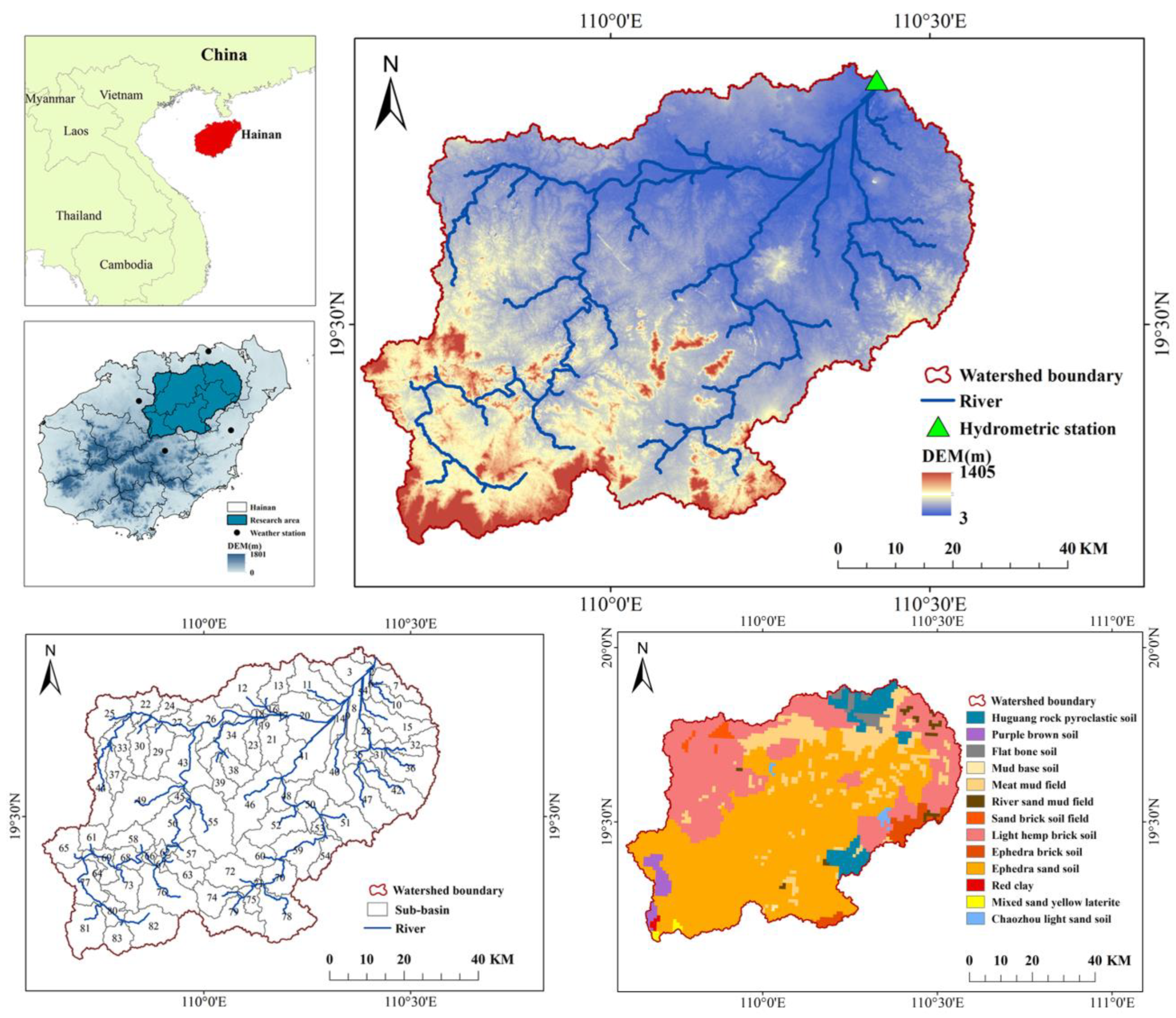
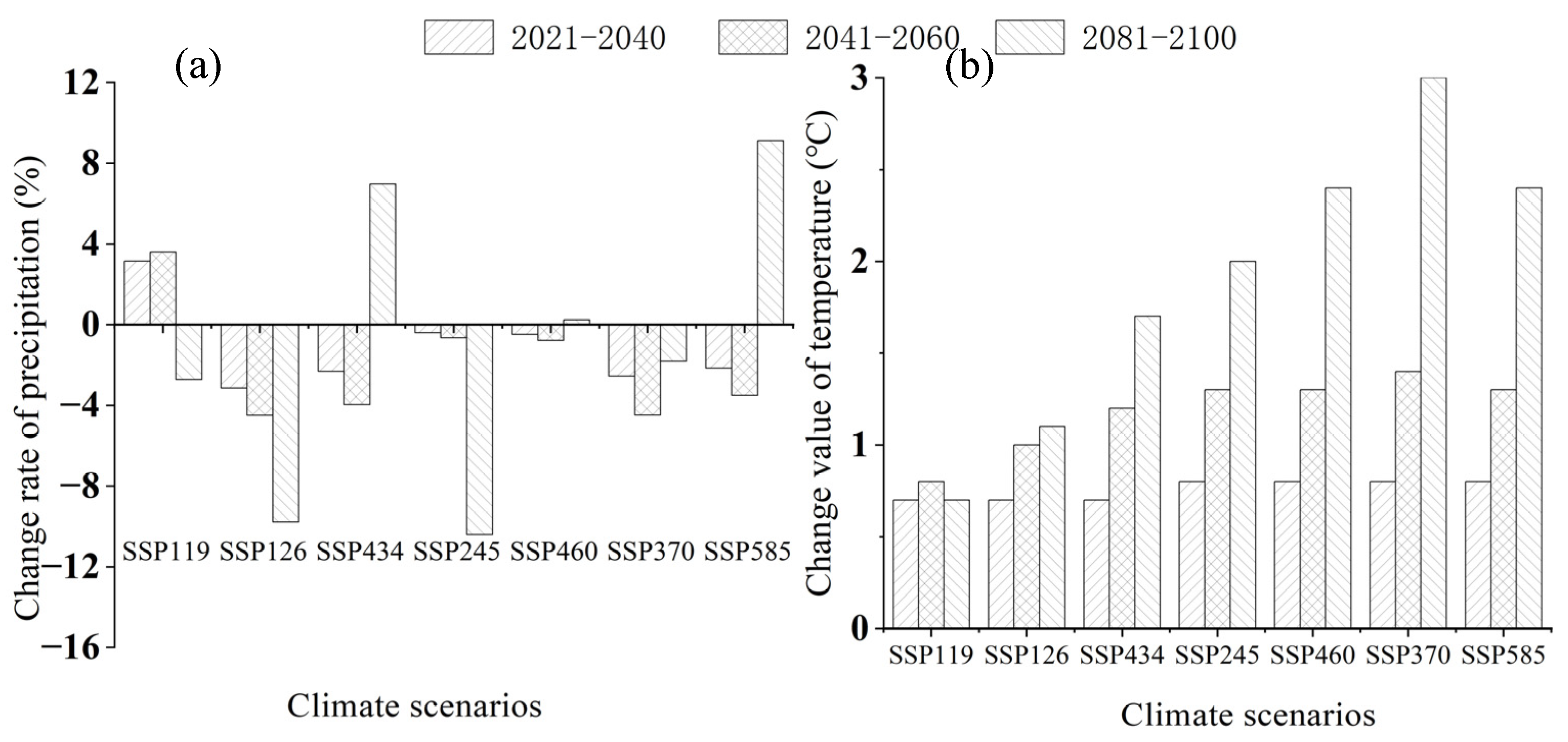

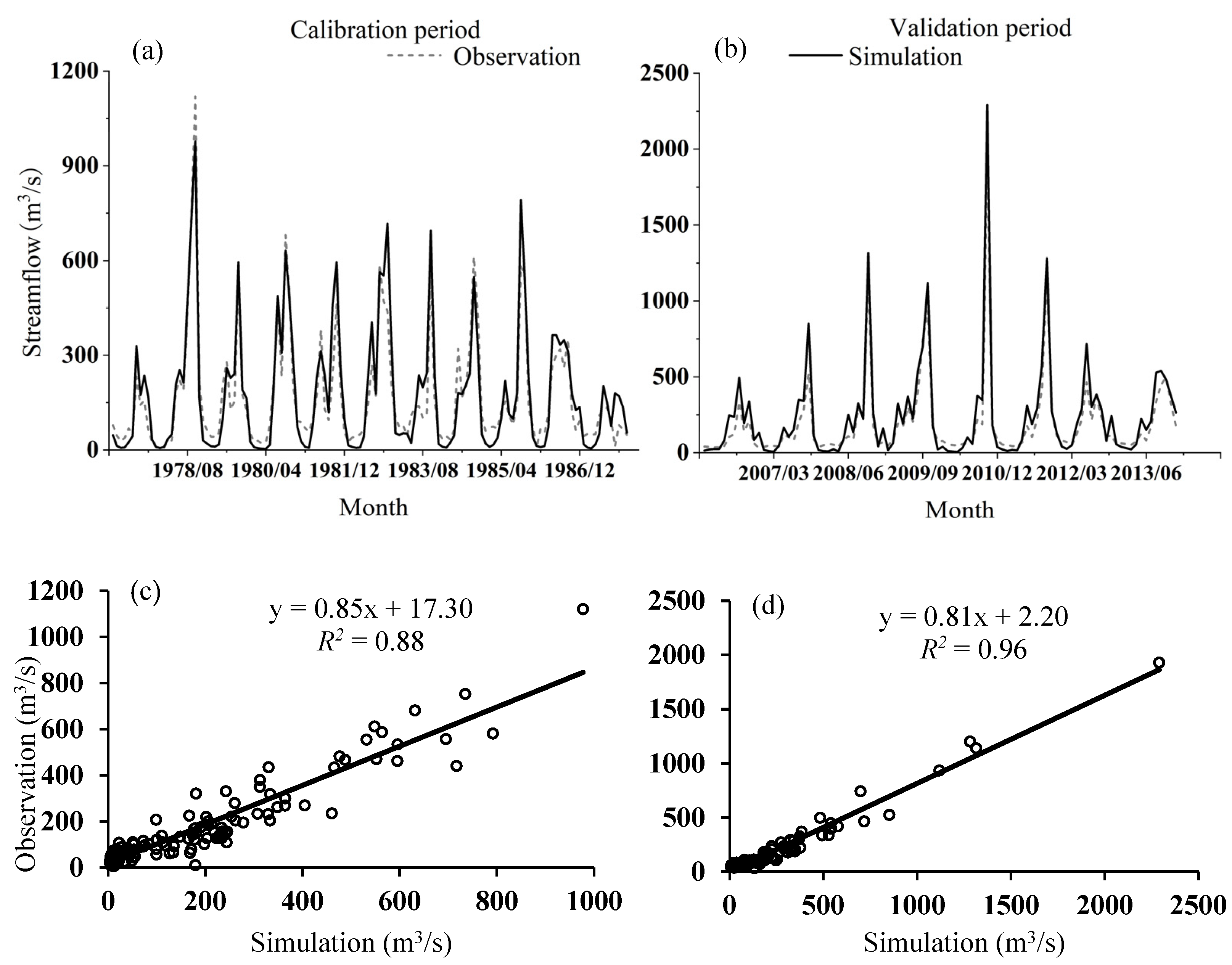
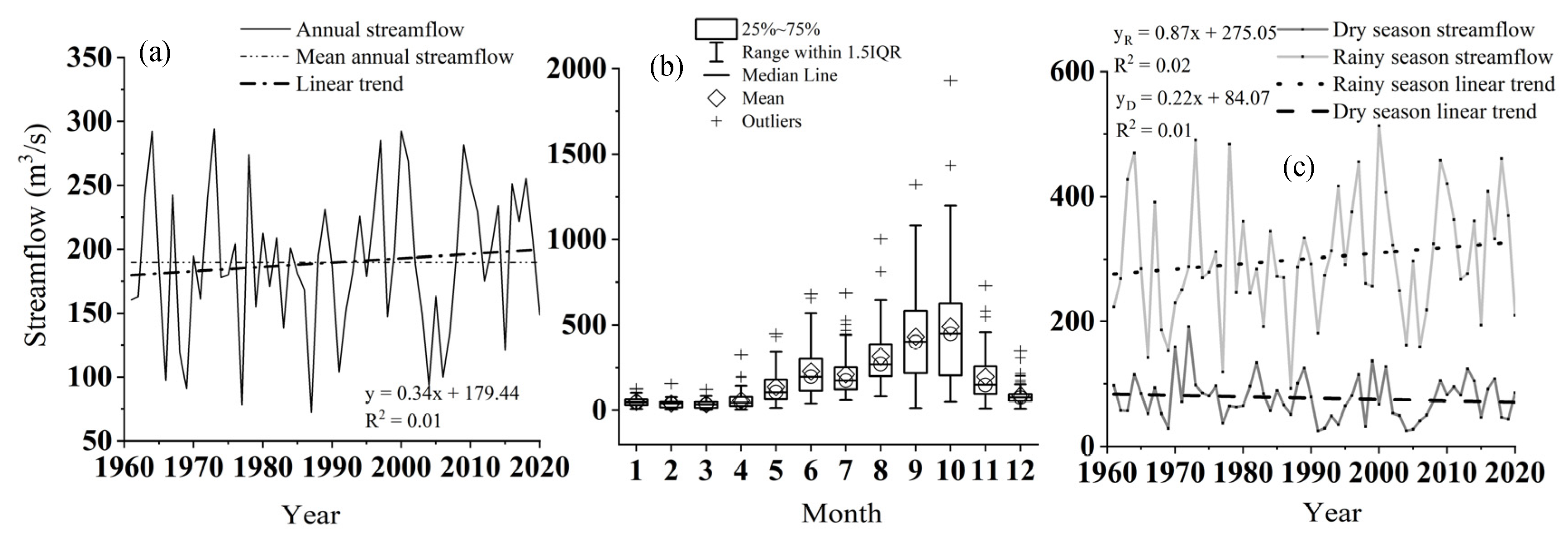

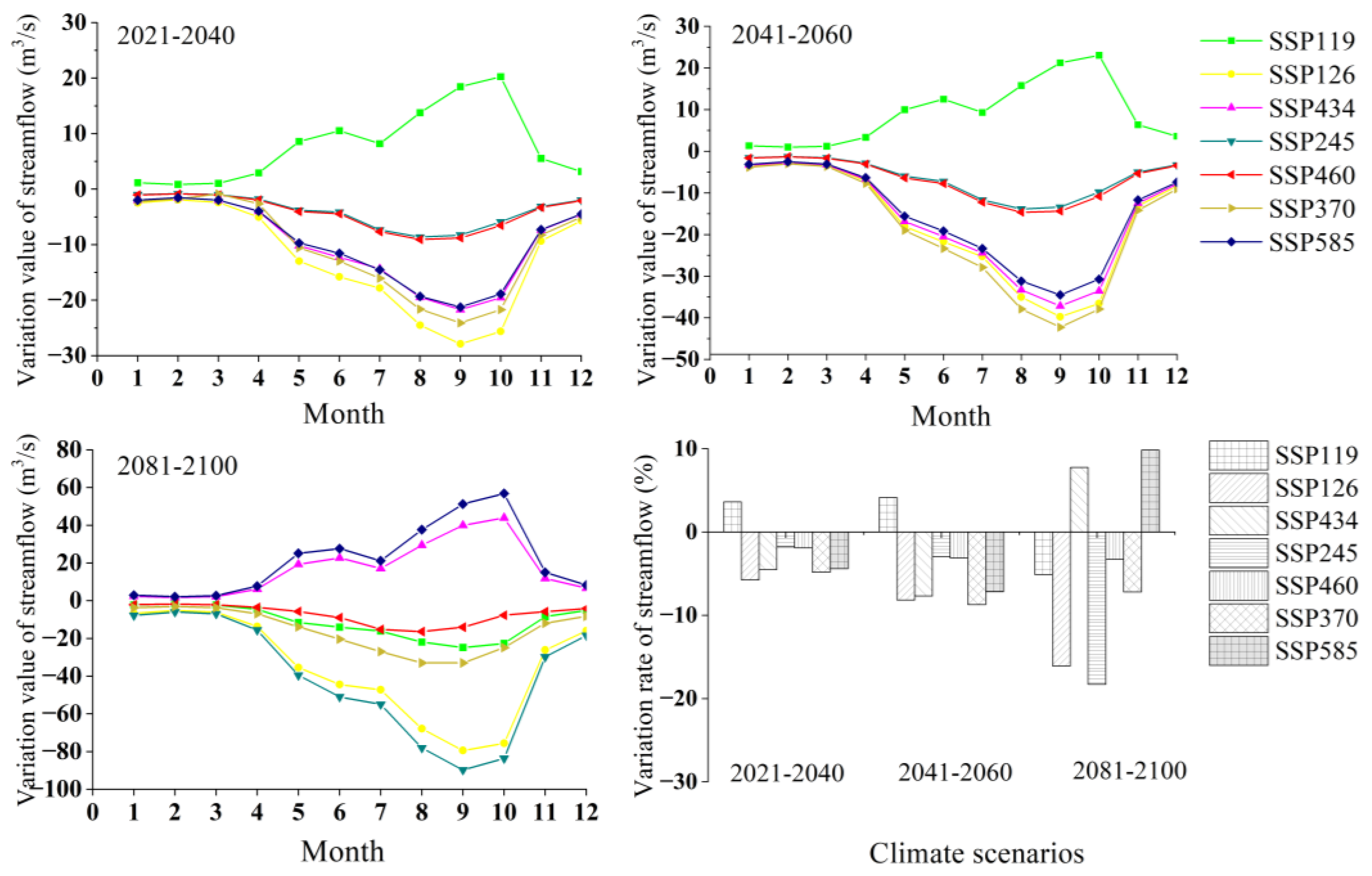
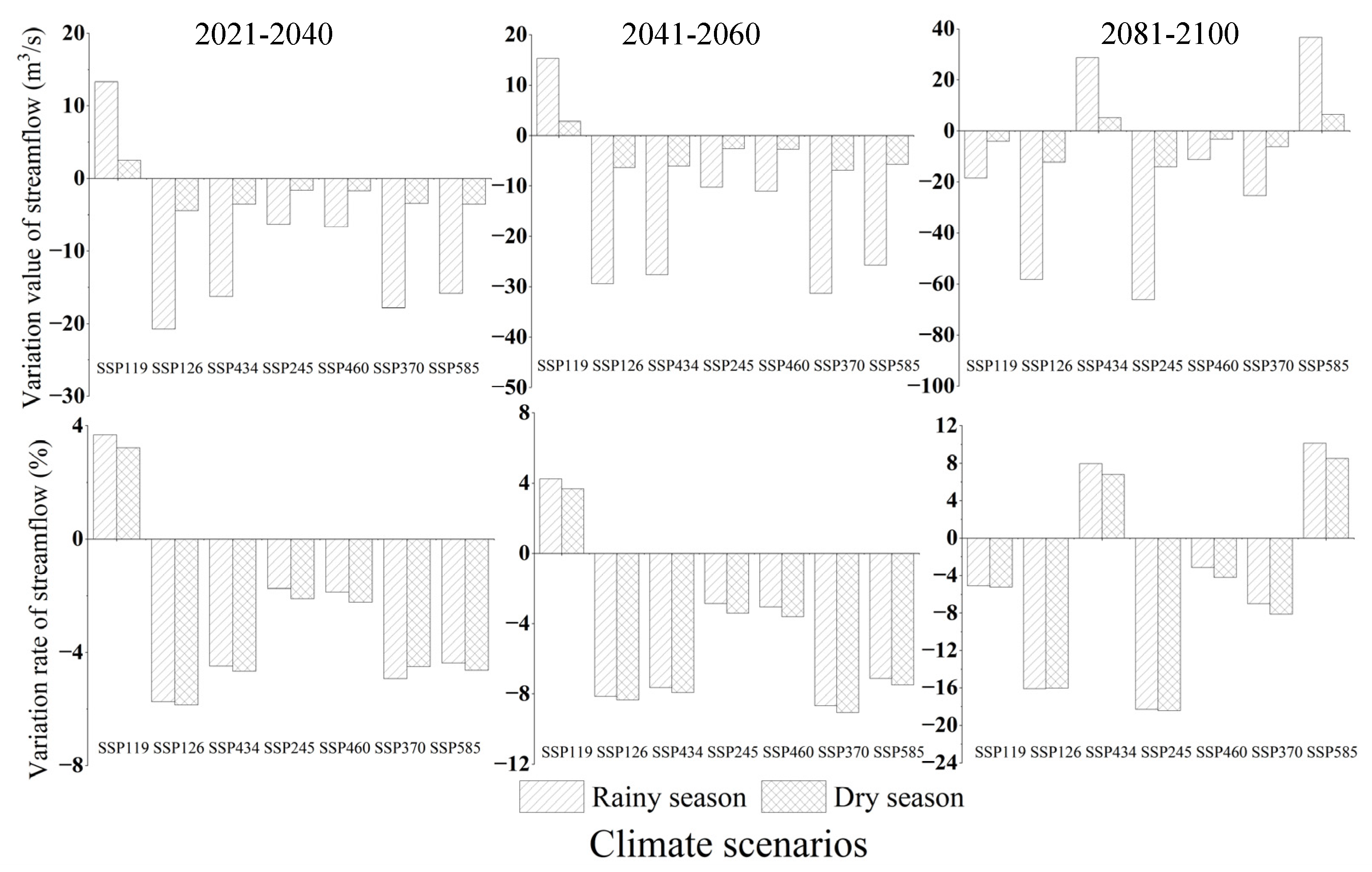
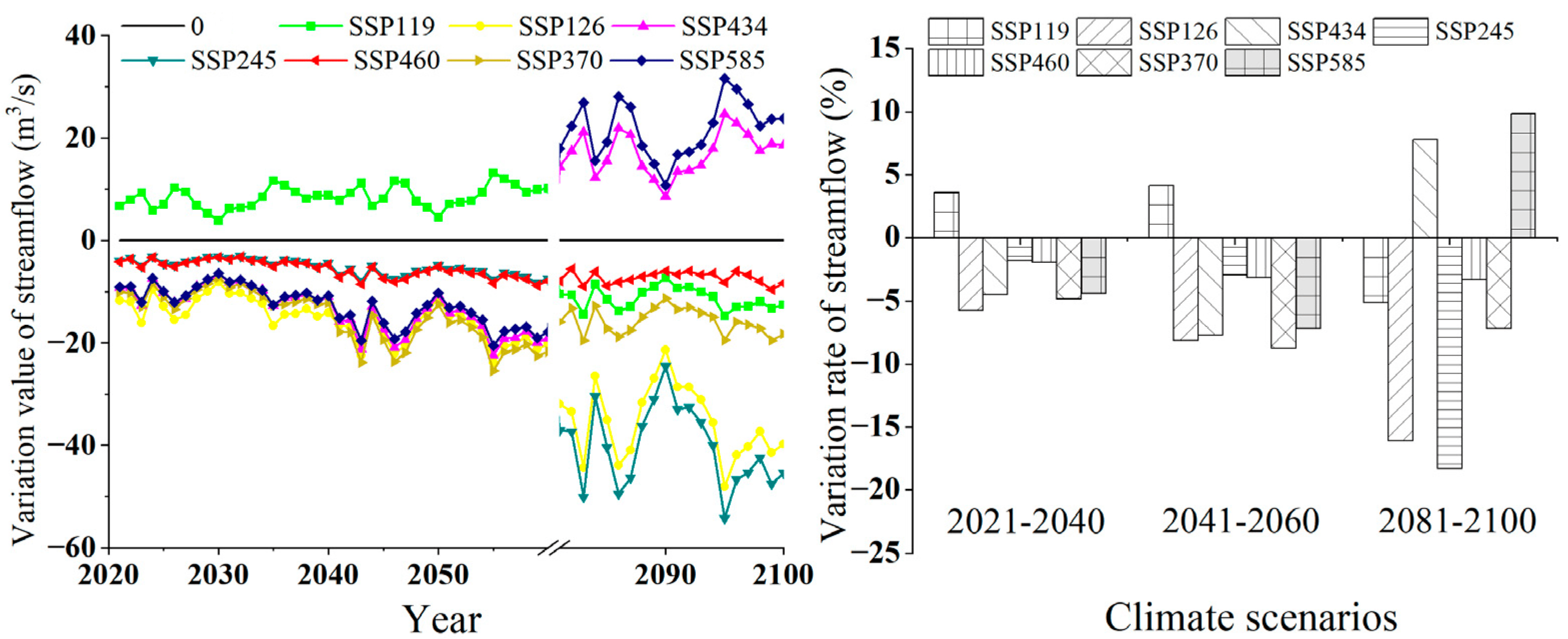
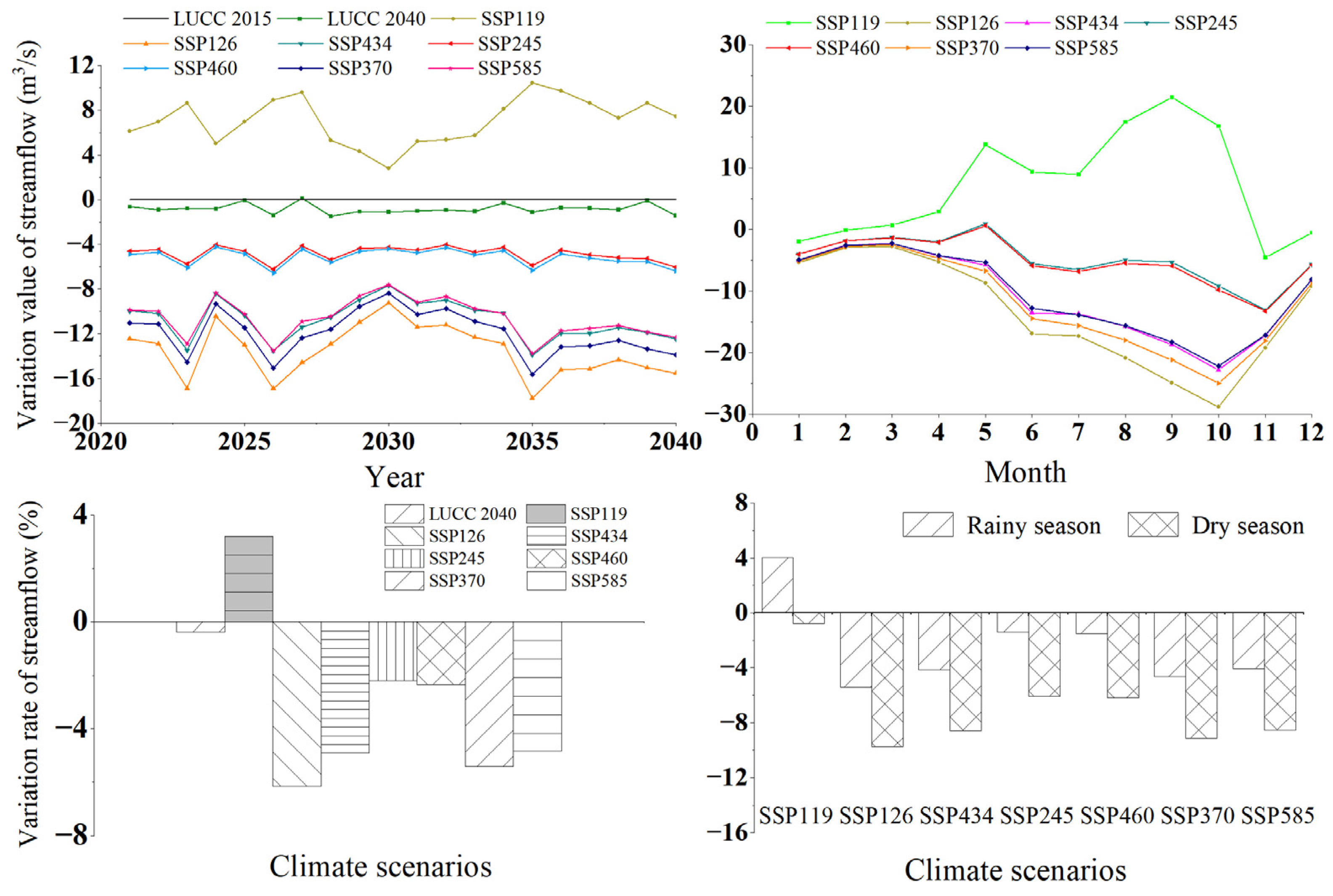
| Data Type | Data Description | Data Sources |
|---|---|---|
| DEM | spatial resolution 30 m × 30 m | The Jet ropulsion Laboratory (http://asterweb.jpl.nasa.gov/ (29 March 2023)) |
| Land use/cover data | spatial resolution 30 m × 30 m | Landsat multispectral image extraction [47,48] |
| Soil classification data | spatial resolution 1 km × 1 km | Resource and Environment Science and Data Center, Chinese Academy of Sciences (http://www.resdc.cn/ (19 June 2023)) |
| Soil attribute data | CLAY, SILT, SAND, ROCK, etc. SOL_BD, SOL_AWC, SOL_K, and other parameters | According to the book [46] and Soil–plant–atmosphere–water (SPAW) |
| Meteorological Data (1961–2020) | Data of daily precipitation, temperature, wind speed, relative humidity, and solar radiation at Haikou, Danzhou, Qiongzhong, and Qionghai meteorological stations | China Meteorological Data Service Centre (http://data.cma.cn/ (19 June 2023)) |
| Hydrological Data (1961–1987, 2006–2013) | Daily streamflow data at Longtang Hydrological Station | Hainan Hydrologic Statistical Yearbook from Hainan Provincial Water Department (http://swt.hainan.gov.cn/ (19 June 2023)) |
| Land Use Type | LUCC 2015/km2 | LUCC 2040/km2 | Area Change/km2 | Proportion of LUCC 2015/% | Proportion of LUCC 2040/% | Proportion of Change Area (Based on 2015)/% |
|---|---|---|---|---|---|---|
| Rubber plantation | 1140.64 | 1209.71 | 69.07 | 21.38 | 22.67 | 6.06 |
| Other forest land | 2488.51 | 2315.29 | −173.22 | 46.64 | 43.39 | −6.96 |
| Tillage land | 1394.42 | 1472.01 | 77.59 | 26.13 | 27.59 | 5.56 |
| Urban and unused land | 209.73 | 234.26 | 24.53 | 3.93 | 4.39 | 11.69 |
| Water body | 102.66 | 104.69 | 2.03 | 1.92 | 1.96 | 1.98 |
| Scenario | LUCC and Climate Change | Streamflow in Dry Season (m3 s−1) | Streamflow in Rainy Season (m3 s−1) | Annual Streamflow (m3 s−1) | |||||||
|---|---|---|---|---|---|---|---|---|---|---|---|
| Climate Change | LUCC | Mean Value | Difference Value | Change Rate (%) | Mean Value | Difference Value | Change Rate (%) | Mean Value | Difference Value | Change Rate (%) | |
| Q0 | 1990 | 1990 | 73.36 | - | - | 286.35 | - | - | 179.86 | - | - |
| Q1 | 2015 | 67.05 | −6.31 | −8.60 | 293.27 | 6.92 | 2.42 | 180.16 | 0.31 | 0.17 | |
| Q2 | 2015 | 1990 | 53.48 | −19.88 | −27.10 | 205.26 | −81.09 | −28.32 | 129.37 | −50.49 | −28.07 |
| Q3 | 2015 | 64.57 | −8.79 | −11.99 | 199.68 | −86.67 | −30.27 | 132.13 | −47.73 | −26.54 | |
Disclaimer/Publisher’s Note: The statements, opinions and data contained in all publications are solely those of the individual author(s) and contributor(s) and not of MDPI and/or the editor(s). MDPI and/or the editor(s) disclaim responsibility for any injury to people or property resulting from any ideas, methods, instructions or products referred to in the content. |
© 2023 by the authors. Licensee MDPI, Basel, Switzerland. This article is an open access article distributed under the terms and conditions of the Creative Commons Attribution (CC BY) license (https://creativecommons.org/licenses/by/4.0/).
Share and Cite
Cao, C.; Sun, R.; Wu, Z.; Chen, B.; Yang, C.; Li, Q.; Fraedrich, K. Streamflow Response to Climate and Land-Use Changes in a Tropical Island Basin. Sustainability 2023, 15, 13941. https://doi.org/10.3390/su151813941
Cao C, Sun R, Wu Z, Chen B, Yang C, Li Q, Fraedrich K. Streamflow Response to Climate and Land-Use Changes in a Tropical Island Basin. Sustainability. 2023; 15(18):13941. https://doi.org/10.3390/su151813941
Chicago/Turabian StyleCao, Can, Rui Sun, Zhixiang Wu, Bangqian Chen, Chuan Yang, Qian Li, and Klaus Fraedrich. 2023. "Streamflow Response to Climate and Land-Use Changes in a Tropical Island Basin" Sustainability 15, no. 18: 13941. https://doi.org/10.3390/su151813941











